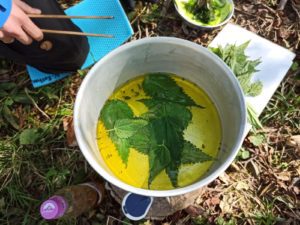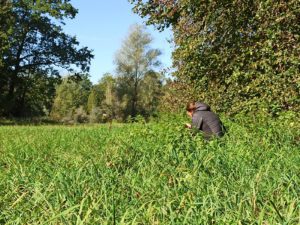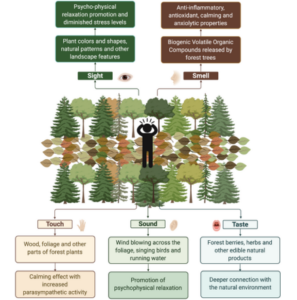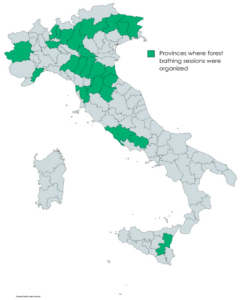Group of Specialists on European Diploma for Protected Areas annual meeting
What is the European Diploma for Protected Areas
The European Diploma for Protected Areas is a prestigious international award granted since 1965 by the Committee of Ministers (Foreign Ministers of each Member State) of the Council of Europe. It recognises natural and semi-natural areas and landscapes of exceptional European importance for the preservation of biological, geological and landscape diversity, which are managed in an exemplary way.
About the meetings and the role of EUROPARC Federation
The Group of Specialists on the European Diploma for Protected Areas annual meeting took place from 20 to 21 February 2024 in Strasbourg and was attended by EUROPARC Federation’s Executive Director.
Our Executive Director Carol Ritchie is a member of the Group of Specialists on the European Diploma for Protected Areas, the body that advises the Committee of Ministers, whether an area in question is of exceptional European interest.
At the meeting, the Group discussed the consequences of the cessation of the membership of the Russian Federation to the Council of Europe and of the freeze of the technical cooperation with Belarus.
There was also the opportunity to reflect how the monitoring of the European Diploma can contribute to the achievement of the Strategic Plan of the Bern Convention and to examine the findings of on-the-spot appraisal visits to seven Protected Areas. Lastly, discussion revolved on the several sites requiring particular attention, and planning the celebration of the 60th anniversary of the European Diploma in 2025.
It was great to see EUROPARC members both in the Group of Specialists and amongst the 66 Diploma sites across Europe (after the exclusion of Russian and Belarusian sites) .
It was especially heartening to see and hear the presentation from Sierra Nevada National Park, Spain, as it made its new application for the Diploma. It is an award that not only looks at the assets of a site but at how they are managed and has high political significance and visibility.
Looking forward to the 60th anniversary
EUROPARC would encourage members across Europe to consider making such an application, especially as the Diploma reaches its 60th anniversary next year. It would be an ideal time to shine a spotlight on the great work being done by Protected Areas to protect our nature in all it is glorious diversity.
For more information
European Diploma holding areasThe EU Parliament adopted the Nature Restoration Regulation
An historic decision from the European Parliament
After a long process started in 2020 with the approval of the EU Biodiversity Strategy and the Commission’s proposal for a Nature Restoration Law presented in June 2022, the EU Parliament formally adopted the trilogue agreement on the proposed new EU Regulation on the 27th of February.
EUROPARC welcomes the decision of the EU Parliament. Michael Hošek – EUROPARC President stated:
It is an extraordinary commitment that comes at the right time to put back nature at the core of EU political agenda.
Nature restoration, to be implemented at scale across Europe, will require massive investments over the coming decades: an estimate of €8.2 billion, according to IIEP report.
The EU Nature Restoration Law, aims to restore degraded ecosystems in all member states, with a target to restore at least 20% of the EU’s land and sea areas by 2030 and all ecosystems in need of restoration by 2050. Member states will also have to adopt national restoration plans detailing how they intend to achieve these targets.
Role of Protected Areas
We anticipate a crucial role will be played by Protected Areas across the EU, as priority for restoration will be given to Natura 2000 sites until 2030.
We also expect Protected Areas to inspire processes for restoration planning and implementation in wider landscapes.
For this EUROPARC will continue to develop tools, methods and explore opportunities to support restoration planning and implementation within Protected Areas, in particular through capacity building and the development of innovative financing methods.
Next steps
The final step in the legislative process is for the agreement to receive the formal approval of Member States, which is expected to take place in March or April this year.
For more information:
To the EC official page To the #RESTORENATURE campaign website Text of the adopted Nature Restoration RegulationGreen-Care project scientific study confirms: mindfulness exercises in nature benefit depressive patients
© Daniel Krebs, Weisbach
A year ago, EUROPARC organised the webinar “Ways to Wellbeing in Nature – Activating Parks and Protected Areas as natural health centres”. We focused on mental health initiatives and dived into experiences from Parks and Protected Areas in our network. The scientific results of the pilot project “Green Care | Nature & Mental Health” are now available in English!
____________________________________________________________________________________________________________
Last December, the German Biosphere Region Berchtesgadener Land, together with the Biosphere Reserve Rhön (Bavarian part) were in the last phase of the Green-Care project. Here, nature-based mindfulness training was tested to support hospitalised patients suffering from several mental health conditions (e.g. depression, burn-out) to discover nature as a resource for their own everyday life. In parallel, courses for prevention purposes were organised for the local residents.
The project was accompanied by a scientific monitoring study (December 2019 – April 2023) from the Catholic University of Eichstätt-Ingolstadt, which released the final report in German earlier this year. We are pleased to also share with you the English version!
For years, the number of people who suffer from depression or anxiety disorders has increased all over Europe, including in Germany. According to the German Psychotherapeutic Association (2021) with the onset of the COVID-19 pandemic, mental stress increased steadily. Despite a dense network of treatment options for mental illnesses, patients have to wait an average of 19.9 weeks for a therapy spot (Bundespsychotherapeutenkammer, 2018). The associated sick days, sickness absence, and reduced productivity are not only an individual burden for patients but also have a huge socio-economic impact on society.

© Christoph Rothmayr, Brennnesselchips
During the project period, the effectiveness of selected mindfulness and relaxation-based nature interventions (“Greencare”) as a supplement to psychosomatic rehabilitation treatment for depressive patients was investigated (case study page). A group of healthy individuals were also offered the mindfulness-based intervention. Treatments were compared to waitlist control groups. In the clinical setting, control groups received treatment in addition to the waitlist.
The results of the scientific research show that both patients with depression from rehabilitation clinics and healthy individuals from the general population seeking preventive measures for stress reduction benefited from the offered mindfulness and relaxation activities in nature. In the clinical setting, patients with higher levels of depression on admission benefited most from the group offerings. Analysis of the questionnaires showed that nature activities enhanced positivity and feelings perceived as stressful were alleviated through the sessions.

© Annemarie Rohrmaier, Pflanzenbegegnung
This effect was still measurable three months after the group sessions, suggesting that the activities were integrated into the participants’ daily lives and had a positive and lasting effect.
One major reason is that different types of activities can be carried out in various natural and cultural landscapes. Practicing the activities in remote forest areas, smaller urban green spaces, wooded areas, and meadows has proved feasible and effective.
The results also indicate that the emotional connectedness to nature, which is a crucial prerequisite for the willingness to engage in nature conservation, increased as a result of the sessions.
The study demonstrated that the innovative offerings provided have been effective.
Forests for Individual and Public Health – Research body and praxis from Italy
Forest bathing session in "Fonte del Borbotto", Florence Province. Photo Archive of Italian Alpine Club
Forest therapy represents the most important “nature-based programme” for health improvement. Since 2019 extensive research has been conducted in Italy to establish scientific criteria and a methodology to develop Forest therapy initiatives across the country.
Our long standing member Italian National Research Council and the Italian Alpin Club were the initiators.
______________________________________________________________________________________________________________
This expert article was drafted by Federica Zabini (Institute of Bioeconomy, National Research Council of Italy – CNR-IBE – Florence) and Francesco Meneguzzo (CNR-IBE and Central Scientific Committee, Italian Alpine Club, Milan).
Global research on the restorative and healing effects of forest environments has expanded in the last decades, with a strong acceleration since the mid-2010s. If progressive urbanisation and consequent nature deprivation appear as the root causes of such an interest, the combination of aging, growing burden of public healthcare expenditures, and increasing concerns for the stability of the global economy have strongly motivated the turning towards natural medicine resources.
Forest immersion to boost human health was a practice in the Far East (i.e. Japan and South Korea). In 1982, the Japanese national Forest Agency introduced a national health programme of forest immersion (Shinrin-yoku) to reduce stress in the workforce. Later, in 2004 a comprehensive research project to investigate the scientific evidence on the healing effects of forest immersion on human health began.
The interest of the international research community gained momentum since 2016 along with Nature Based Interventions. Later and following the COVID-19 pandemic [1] the UN the recognised forest therapy benefits as a tool for green recovery [2].
A growing body of evidence shows the relevance of nature experience and “green care”. Also, exposure to forest settings has been rigorously linked to both psychological and physiological health benefits.
Forest therapy and related mechanisms
Forest therapy, often named also “forest bathing”, represents the most important “nature-based programme” dedicated to health improvement in the strict sense. Forest therapy initiatives are now spreading globally and resulting in a great diversity of activities.
However, to date, with the exception of Japan, South Korea, and more recently China, these local-level initiatives are largely not embedded in institutional frameworks, from the choice of suitable sites to other elements allowing the achievement of desired health outcomes.
What are the conditions and features of a forest therapy trail allowing to achieve statistically significant health outcomes and thus potentially the incorporation into official clinical treatments?
Forest therapy engagements take place via slow walks along forest trails that facilitate multi-sensory, immersive experiences. Beneficial effects of forest therapy derive from the combined stimulation of all senses, induced by specific features of the natural environment.

Sensory components of forest bathing and their effects on individual well-being.
Image from: Antonelli M, Donelli D, Carlone L, Maggini V, Firenzuoli F & Bedeschi E (2022) Effects of forest bathing (shinrin-yoku) on individual well-being: an umbrella review, International Journal of Environmental Health Research, 32:8, 1842-1867, DOI: 10.1080/09603123.2021.1919293
Disentangling the contribution of single stimuli to the observed effects on human health is hard, due to many confounding factors, either environmental or personal, with stimuli often acting synergically.
Several studies showed that the main factors positively affecting the restorative and relaxation effects of the immersion in forest environments are:
- Naturalness: natural, wild, and uncontaminated forests, with large, old trees, overcoming urban and commercial forests;
- Biodiversity: diverse vegetation communities, high species richness and abundance, native species, vegetation density;
- Forestry structures: easily accessible, open and bright environments;
- Presence of water (e.g. waterfalls, streams);
- Distant view of scenic landscapes (e.g., mountains);
- “Environmental coherence“: the absence of disturbing factors (e.g. plantations, artificial sounds, poorly integrated infrastructure)
Evidence-based standard for a European forest therapy service system – an experience from Italy
Among other contributing factors, the inhalation of biogenic volatile organic compounds (BVOCs) emitted by plants and soil into the forest atmosphere, particularly monoterpenes (MTs), have been suggested as one of the determinants of the health benefits of forest immersion experiences.
The identification of suitable sites to build a networked forest therapy service system requires the consideration of the characteristics of forest sites and trails, and to substantiate the ongoing spreading of forest therapy practices by adopting recognized, evidence-based standards, for the acceptance of forest therapy as a part of officially recognized medical treatments.
In Italy, the effort to establish scientific criteria and a methodology to develop Forest therapy initiatives started in 2019, with a joint project between the Italian Alpine Club (CAI) and the National Research Council of Italy (CNR), which expanded since 2021 to the Italian Ministry of Agricultural, Food and Forestry Policies, CREA (Council for agricultural research and analysis of agricultural economics), Italian National Institute of Health (ISS), and few Italian University Departments.

Source: Antonelli, M.; Donelli, D.; Maggini, V.; Gallo, E.; Mascherini, V.; Firenzuoli, F.; Gavazzi, G.; Zabini, F.; Venturelli, E.; Margheritini, G.; et al. Demographic, Psychosocial, and Lifestyle-Related Characteristics of Forest Therapy Participants in Italy: A Multicenter Cross-Sectional Survey. Healthcare 2023, 11, 1627. https://doi.org/10.3390/healthcare11111627
The participants engaged in a forest therapy session guided by psychologists or psychotherapists following a standardized protocol, lasting approximately 2.5 hours. The session involved slow walking of short duration, with pauses of 15 minutes at five different spots. At each stop, individuals were encouraged to focus on one sense (visual, auditory, tactile, olfactory perception). The protocol includes a 20-minute stop for free immersive activity.
A very extensive campaign was arranged between June 2021 and October 2022, at 39 forest sites across Italy, including mountain, hill, and urban park settings, with more than 1300 adults participating to standardized forest therapy experiences [3].
The large database built upon such campaign allowed to achieve important and original results. For the first time, it was shown that the inhalation of plant-emitted MTs, and in particular α-pinene, produced a specific, dose-dependent anxiolytic effect, independent of any other factor. About 30% of the overall reduction in anxiety symptoms achieved after 2.5-hours of forest therapy sessions in environments endowed with above-the-average MTs concentration, were attributable to the exposure to MTs themselves, with a significant dose-dependent size of the anxiolytic effect [4].
Another study, performed in cooperation with the “Pio XII Institute” Altitude Pediatric Asthma Center at Lake Misurina, eastern Italian Alps, found statistically significant associations between the quantity of monoterpenes inhaled by asthmatic adolescents admitted to the rehabilitation camp and the improvement of their respiratory functions, according to several different measures; such an effect was related to the benefits on the patency of the small airways [5].
These results allowed to define the direct therapeutic role offered by the exposure to forest settings with regards to anxiety and asthma symptoms, and to identify the direct dependence of the health effects on the dose of inhaled monoterpenes.
Moreover, the same results allowed to define some objective criteria for identifying Forest Therapy stations capable of providing clinical level services and assign a specific therapeutic value to each forest and nature site, depending on plant species, extension of forest stands, altitude, climate, and conditions on the season and the period of the day.
Forasmuch as the economic value of protected natural areas, assessed based on the improvement of the mental health of visitors, amounts to about 6% of global gross domestic product (GDP) [6,7], and that anxiety imbalances have been associated with a 52 % increased risk of cardiovascular diseases (CVD), independently of any other risk factors [8,9], any effort aimed at increasing the ecosystem functions and services of natural and protected areas towards human mental and physiological health, including conservation and protection of biodiversity, is widely justified based on benefits to both individual health and public healthcare budgets.
